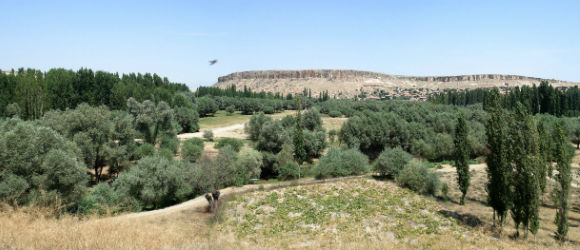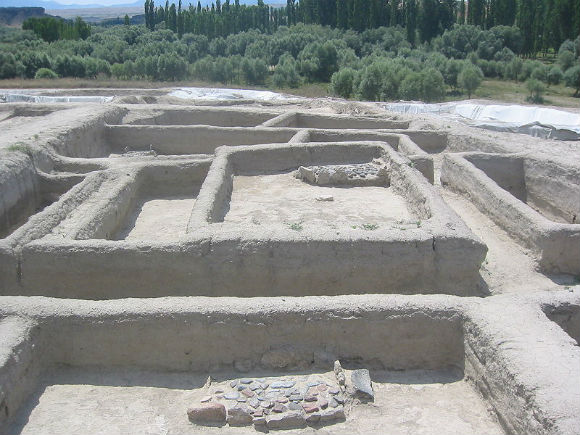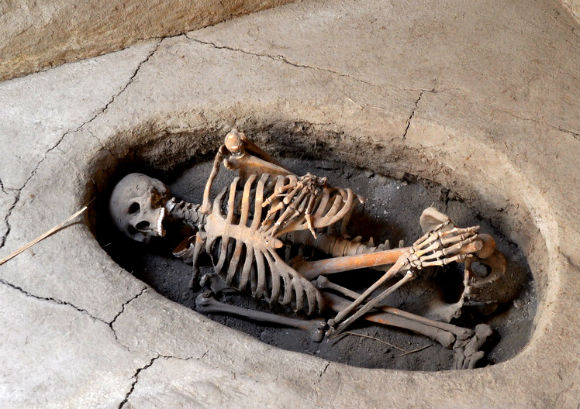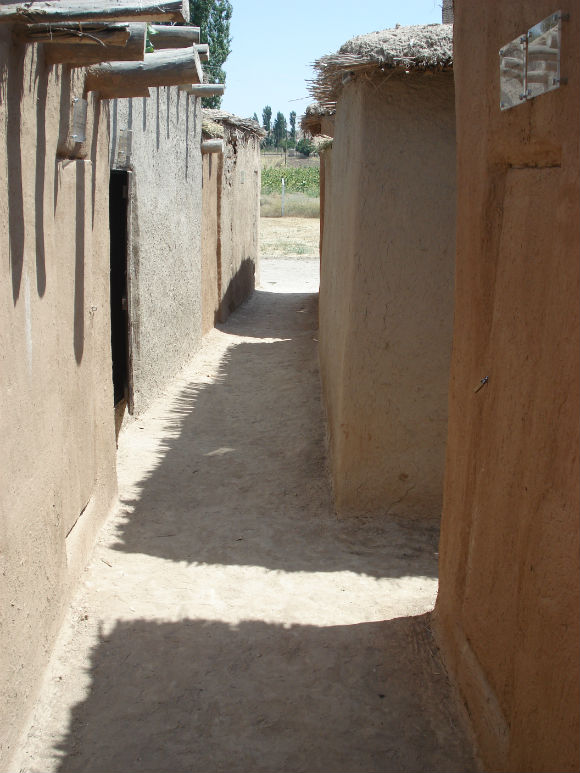Asikli Huyuk is a settlement mound located nearly 1 km south of Kızılkaya village on the bank of the Melendiz brook, and 25 kilometers south – east of Aksaray, Turkey. Aşıklı Höyük is located in an area covered by the volcanic tuff of central Cappadocia, in Aksaray Province. The archaeological site of Aşıklı Höyük was first settled in the Aceramic Neolithic period, around 8000 B.C.
It is situated 1119.5 metres above sea level; a little higher than the regions average being ca. 1000 metres. The site itself is about 4 ha,considerably smaller than the closely situated site of Çatalhöyük (13 ha). The surrounding landscape is formed by erosion of river valleys into tuff deposits. The Melendiz Valley, where the Aşıklı Höyük is located, constitutes a favourable, fertile, and diverse habitat. The proximity to an obsidian source did become the base of a trade with the material supplying areas as far away as today’s Cyprus and Iraq.
Aşıklı Höyük was first investigated by Professor Ian A. Todd when he visited the site in the summer of 1964. Todd emphasised the importance of the obsidian in the area, based on over 6000 obsidian pieces collected from the surface layer alone. The site was classified as a medium sized mound and partly destroyed by the river situated next to it. On the basis of the lithics and animal bones located in the surface layers the site got known as a contemporary to the Palestine PPNB, which later got reinforced by C14 dates (based on five unstratified radiocarbon dates going from 7008 ± 130 to 6661 ± 108).The first comprehensive excavations took place relatively late: first when the government launched a plan that would result in the rise of the waters of the Mamasın Lake located close to Aşıklı Höyük, Professor Ufuk Esin (University of Istanbul) started the salvage excavations in 1989. There have been altogether undertaken nine excavations to the year 2003; uncovering approximately 4200 m2 on the horizontal plain, making it one of the largest scale excavations in the region.
The newest dates for Aşıklı Höyük show that the occupational period was from 8200 – 7400 BC, extracted from 3 layers with a total of 13 phases; which places it in phase ECA II (correlating with the E/MPPNB in the Levant). It is known as one of the earliest Aceramic Neolithic sites on the Anatolian plateau, and the prior mentioned extraction of the obsidian source was likely to be frequented as far back as the Paleolithic nomadic hunter-gatherers.Due to its date and structural organization Aşıklı Höyük is known to be “(…) a prime example of a first foray into sedentism”.
After more than 400 rooms have been excavated the total number of individual buried within the settlement did not surpass 70 individuals. All these burials were located sub-floor inside buildings. The dead were placed in pits cut through the floor during the occupation of the building. The buried are people of both sexes and all ages. There is a variety of skeletal body postures; from burials in a hocker (fetal) position to extended skeletons facing upwards. Others are lying on one side, occasionally with the legs bent at the knees.The orientation of the burials varies within the buildings, likewise does the number of individuals buried inside them.
57 years of age, while the majority of females died between the ages of 20-25. The skeletal remains of these women show spinal deformities indicating that they had to carry heavy loads. This does not itself prove that there was a division of labour between the sexes. The fact that the men seem to have outlived the women might be interpreted as sign that the women were subject to more strenuous physical labour than their male counterparts. From Natufian Abu Hureyra there are similar osteological signs; such as pathologies in metatarsals, phalanges, arm, and shoulder joints – being specific to females resulting from habitual kneeling in the use of saddle querns. The Neolithic evidence show indications of increased physical workload in the osteological material on both genders, where the male skeletons show signs of joint disease and trauma arguably caused by cutting timber and tilling.
Children represent 37. 8% of the deceased, with 43.7% of them passed away within the first year after birth. The skeletal remains are complete and with articulations intact, indicating that the burials have been primary. The graves contain either single or double burials. On one occasion two graves were found under the floor of room AB, belonging to an adjacent court (HG) with a large domed mudbrick oven paved with blocks of basalt. In one of the graves the skeletons of a young woman and an elderly man; in the other a young woman buried together with her baby. The young woman had apparently undergone trepanation and survived only a few days after the operation. All skeletons were buried in the hocker position, a fetal-like positioning were the arms are embracing the lower limbs. From a different grave a woman shows signs of being scalped immediately after her death, according to the cut marks on her skull. As many as 55% of the skeletons show signs of being burned. The burial under the floor AB is accommodated by walls with the interior side were painted in a purplish red colour. The oven in HG indicates that this was indeed “special individuals of an elite class”; claiming it can be compared to the “Terrazzo” Building at Çayöyü and the “Temple” Building at Nevalı Çori and therefore have been a shrine used for religious ceremonies. Many of the burials contain burial goods consisting of necklaces and bracelets made of beads of various sorts.
70 burials in over 400 rooms suggest that some form of selection took place of who was buried at the site, implementing that AB indeed could be the residence or resting place of people influential in terms of both economy and political power. Rooms containing hearths are more likely to contain burials; as many as 77%. It has been argued that the number of burials could be an underrepresentation inhered at the site, since a large part of the settlement remain unexcavated beneath the baulks. Later excavations which have been published suggest on the other hand that burials were not a general feature at Aşıklı Höyükand therefore the suggestions of burials being a privilege of the elite class do seem plausible. There has not been found a cemetery or any other sign of where the rest of the population might have been disposed of post mortem. This issue is not only limited to Aşıklı Höyük: there is also a lack of cemeteries on the PPNB “mega-sites” in the Levant, such ‘Ain Ghazal in the Jordan Valley.
It seems that in Aşıklı Höyük, as in the rest of the Anatolian and Levantine area, the burial and any other post mortem treatment was arguably an “upper class” phenomenon. This interpretation has been opposed; referring to the diverseness of individuals in both sex and age in the graves. The burials including such a wide range of individuals do not directly coherent with the image of an “upper class” phenomenon. Burials could have been removed or replaced over time, giving a wrong image of the burials as belonging to the elite. An alternative perspective has been suggested: “(…) the Neolithic dead are not under-represented: rather, it is the architecture in settlements that are over-represented”, meaning that in many cases archaeologists have drastically overestimated the extent to which all areas of Neolithic sites were occupied simultaneously. As for Aşıklı Höyük and other sites in the area: low numbers of burials in comparison with occupation span does not directly indicate a cult of the elite.
Aşıklı Höyük,





Asikli Huyuk had a tradition to reconstruct or rebuild earlier structures. It followed a pattern where the structures were built “exactly on the same spot and with the same alignment as earlier buildings, using older walls as a foundation”
A 10,000 year old Neolithic settlement lying in the volcanic landscape of Cappadocia, on the bank of the Melendiz river. For at least twenty generations people of Asikli Huyuk lived in mud brick houses.
The houses in Asikli Huyuk had hearths and burial pits beneath the floors; in rare cases they had bins and benches. Middens and special function buildings were communal. Besides practising farming they made extensive use of wild plants and animals.